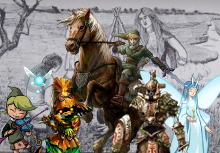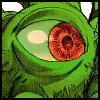Zelda and Mythology: Celtic Myth
Posted on March 15 2013 by Axle D. Wilder
 What does Zelda borrow or mimic from Celtic myths? Celtic mythology is responsible for such Zelda staples as Epona and Fairies, and there are a number of other notable and even shocking consistencies between the mythology and the Zelda series. Celtic myth is about warriors and heroes sent into battle instead of gods and spirits to save lands, fight evil creatures, rescue fair maidens, and discover magical artifacts. Zelda is modeled after fantasy tropes, and many of them date back to Celtic mythology (though they can be found in other mythologies as well). I’ve discussed Arthurian Legend before — a Christianized subset of Celtic mythology — so now I’ll talk about the broader set of myths. Let us start with the most striking connections.
What does Zelda borrow or mimic from Celtic myths? Celtic mythology is responsible for such Zelda staples as Epona and Fairies, and there are a number of other notable and even shocking consistencies between the mythology and the Zelda series. Celtic myth is about warriors and heroes sent into battle instead of gods and spirits to save lands, fight evil creatures, rescue fair maidens, and discover magical artifacts. Zelda is modeled after fantasy tropes, and many of them date back to Celtic mythology (though they can be found in other mythologies as well). I’ve discussed Arthurian Legend before — a Christianized subset of Celtic mythology — so now I’ll talk about the broader set of myths. Let us start with the most striking connections.
Epona, Link’s iconic steed, borrows her name from Celtic mythology. Seemingly originating from Gallo-Roman religion — a fusion of the traditional religious practices of the Celtic Gauls, and the religions introduced under Roman Imperial rule — Epona was a goddess of fertility and protector of horses, donkeys, and mules. She also may have been a psychopomp (guide to the afterlife). The only important connections to Zelda are the name and its association with horses, but they are clearly taken directly from mythology.
Zelda’s concept of the fairy is a more benevolent version of the winged, rarely-benevolent fairy from myth and literature. Fairies, although they feature in many other cultures, are prominent Celtic myths, and fall under broad classification. Sometimes considered to be angels, demons, the dead, an old race driven into seclusion, or simply spirit beings, creatures identified as fairies have appeared in a huge variety of forms.
 Fairies are often cruel pranksters, or even far more malicious entities. For an extreme example, take the Scottish Nuckelavee, a monstrous Cyclopean centaur-like beast with no skin and black blood that spreads poison and drought. Fairies are also known to steal children and replace them with Changelings, their own offspring. At their best, fairies are tricksters. Various strange entities in Zelda games, like the trickster Skull Kid, the Deku, and even the Kokiri themselves, fit the description of the mythological fairy. The Skull Kid’s trickster qualities are especially apparent in Twilight Princess. The only game in the series where the fairies themselves are tricksters is Majora’s Mask with the fairies Tatl and Tael. Zelda’s fairies seem to be based more on the usually benevolent pixies, and the Minish also bear heavy similarities to these creatures.
Fairies are often cruel pranksters, or even far more malicious entities. For an extreme example, take the Scottish Nuckelavee, a monstrous Cyclopean centaur-like beast with no skin and black blood that spreads poison and drought. Fairies are also known to steal children and replace them with Changelings, their own offspring. At their best, fairies are tricksters. Various strange entities in Zelda games, like the trickster Skull Kid, the Deku, and even the Kokiri themselves, fit the description of the mythological fairy. The Skull Kid’s trickster qualities are especially apparent in Twilight Princess. The only game in the series where the fairies themselves are tricksters is Majora’s Mask with the fairies Tatl and Tael. Zelda’s fairies seem to be based more on the usually benevolent pixies, and the Minish also bear heavy similarities to these creatures.
Related to the fairies are the Aes Sídhe, a supernatural race, often considered to be fairy folk themselves. They are sometimes equated with the Tuatha Dé Danann, an old, fallen race of divine immortals who can be likened to the Hylians. These beings were a supernatural people who lived in “fairy mounds” or mystical Otherworlds, which range from apparent pocket dimensions, to spirit worlds, to places that are simply strange, to afterlives.
These Otherworlds bring to mind magical places like the Sacred Realm, Twilight Realm, and Silent Realm. Celtic Otherworlds ranged from idyllic places like Annwn or Avalon, paralleling the Sacred Realm (as I wrote in the Arthurian Legend article), to alien locations like the Twilight Realm, or dangerous hellish landscapes like the Dark World. Characters would journey to these places to save maidens, complete challenges and retrieve treasures, or would pass in and out on spiritual journeys. In Skyward Sword, Link enters the Silent Realm to grow spiritually and be rewarded with an artifact needed to progress.
Fairy Fountains buried underground bring to mind the fairy mounds of the Aes Sídhe, whom the Great Fairies could be said to resemble with their greater stature and greater importance over their smaller kin. Locations like the Queen of the Fairies’ home in Mother and Child Isles from The Wind Waker also come very close to these Celtic Otherworlds and fairy homes. Even Link’s strange and surreal journeys to worlds like Koholint Island, Termina, and the World of the Ocean King mimic spiritual journeys to the Otherworlds, or being stranded in them.

Many of Zelda’s gods, spirits, and other creatures match the many forms of fairies, elves, Aes Sídhe, and other Otherworld-dwelling creatures; the deformed and violent Fomorians bring to mind evil tribes like Bokoblins and Bulblins, and their status as old gods of chaos that rival the Tuatha Dé Danann mirrors the Bokoblins’ status as demons who plague the Hylians. While these sorts of creatures typically take more immediately after Eastern beliefs — many spirit entities like the Deku Tree or the Wind Gods are clearly Japanese Kami, while the Bokoblins of Skyward Sword resemble their Oni — they still very much resemble Celtic fairy folk in spirit, with the fairies themselves and tricksters like the Skull Kid forming more direct references to Celtic mythology specifically. Otherworlds appear in other myths, and it’s unclear if Zelda’s abundance of alternate realms and spiritual planes is intended as a reference to these, but the similarities are too striking to ignore.
Various magic-users feature prominently in Celtic mythology. Beyond Merlin, many magic-users in Arthurian Legend are portrayed as evil witches, but in broader Celtic myth, there are many benevolent magicians as well. Among these are the druids, generally spiritual leaders of the Celtic people, said in myth to have magic powers. Zelda’s many magic-users and particularly their sages and spiritual, tribal leaders hearken to this. Druids were also seers, and prophecies factor into many Celtic myths — especially Arthurian Legend. Once again, this is not unique to Celtic myth by any means and is one heck of a fantasy trope, but it still forms another likeness between Zelda and Celtic mythology; in the myth, the prominent spiritual leaders were seers and prophets, whereas in Zelda, the amount of times I can recall hearing the words “foretold” or similar is staggering.
 Even the Zelda series’ frequent fixation on musical subthemes can be connected to Celtic mythology, where bards were sometimes said to have had spiritual journeys to the Otherworlds and magical power in their rhymes, poems, and songs. Zelda’s many musical instruments have nearly always had magical or sacred importance, and songs have often functioned as keys to dungeons and other fantastic realms: The Song of Time opens up the Sacred Realm that resembles the Otherworld Annwn, songs in The Wind Waker open up the Earth and Wind Temples, Howling Stones allow Link to commune with his dead ancestor in a strange spirit world, and the harp songs in Skyward Sword open up the spirit trials in the Silent Realm.
Even the Zelda series’ frequent fixation on musical subthemes can be connected to Celtic mythology, where bards were sometimes said to have had spiritual journeys to the Otherworlds and magical power in their rhymes, poems, and songs. Zelda’s many musical instruments have nearly always had magical or sacred importance, and songs have often functioned as keys to dungeons and other fantastic realms: The Song of Time opens up the Sacred Realm that resembles the Otherworld Annwn, songs in The Wind Waker open up the Earth and Wind Temples, Howling Stones allow Link to commune with his dead ancestor in a strange spirit world, and the harp songs in Skyward Sword open up the spirit trials in the Silent Realm.
Beyond these more specific connections, it’s worth noting that Celtic mythology in particular frequently featured tales of heroic quests and many heroes. Most famous of these is the Grail Quest in Arthurian Legend, but other examples exist, such as Culhwch’s quest to complete nine dangerous tasks so he could marry Olwen at the behest of her father, the giant Yspaddaden, and many other questers like Art and Bran. Other iconic heroes like Cu Chulainn abound. There’s little more to say about this other than that there are many heroes, and many quests and journeys undertaken in Celtic mythology.
With that in mind, you can almost say that out of all myths, Celtic mythology is the one that Zelda most resembles. They are both tales of heroes and fantastic lands with strange creatures and gods. Even the ancient tales of Celtic mythology’s old gods, the Tuatha Dé Danann and the Fomorians, show the two as old enemies just as Zelda pits similar races against each other; most of the similarities between Celtic myth and Zelda line up perfectly. The Celts even believed in reincarnation, just as many Zelda fans think that Link and Zelda may actually reincarnate from game to game, and Demise is implied to reincarnate as Ganondorf. Like I wrote about the similarities between Zelda and Arthurian Legend, I doubt that the majority of these are intentional references — aside from the obvious borrowings — but that doesn’t make it any less interesting to identify those similarities and see how truly similar they really are. And even without doing so, it’s clear that some of Zelda’s most iconic features — Epona, its Fairies — come from Celtic myth.
It’s a very interesting and just plain cool set of similarities that I wouldn’t mind seeing expanded; more strange locations and mystical tribes like the Otherworlds and fairy folk would be welcome in the series, especially if Nintendo took it further and crafted a particularly alien landscape with them. Then again, Zelda could always stay as it is and borrow from these myths only in part. What do you think? How much of this were you aware of before now? Did you know where Epona’s name came from? Did you learn anything? What do you think of Zelda’s relationship with and similarities to Celtic mythology? Tell me in the comments!





